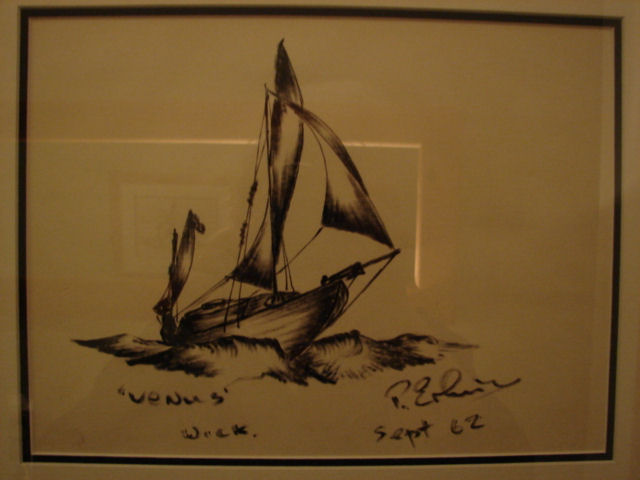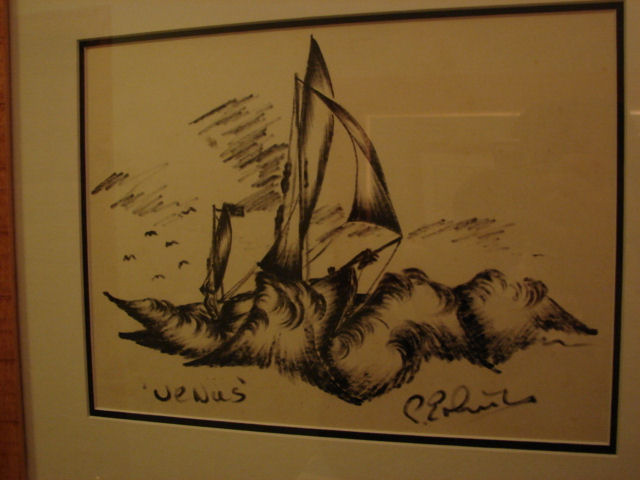|
I first met Paul Johnson in the late sixties, he was sailing a twenty-eight footer of his own design, that he built in
Florida, using wood from an old church. I had never seen such a boat. She was tubby yet elegant, and beautifully rounded from
every angle. Sporting a gaff rig and having no cockpit she drew me closer. I could just make out the name of this double ended
visitor. "Venus".
We didn't get many boats arriving in Bermuda in those days. The cruising
craze of the seventies hadn't yet started, and most of the boats and sailors that stopped in Bermuda are today well known.
The Hiscocks in "Wanderer", Frank Mulleville in "Girl Stella", and John Riding in his twelve foot "Sea
Egg", or "Sjo Ag" to name a few.
The next day I sculled out to "Venus" in my small
pram. Just a few weeks before I had sculled out to another British yacht called "Wanderer" . After complimenting
me on my sculling ability, they invited me aboard, and I ended up by having tea and spending a few hours at anchor with Eric
and Susan Hiscock. I was only thirteen, and this was exciting. Could I be so lucky as to be invited aboard again?! There was
no sign of life as I circled Venus. She had the most rounded deck I had ever seen, and no lifelines. How did her owner keep
from falling off. As I pondered this a voice hailed me from the single porthole in the doghouse. "Come aboard! Come below"
As I decended the steep companionway ladder I entered another world. Though the boat was small the cabin was huge!
And full of stuff! A Seagull outbard, sails, ropes, anchors. I felt more like I was in a cave than a boat, and I liked it
immediately! Suddenly I was face to face with a young man with a beard and kind twinkling eyes. "I am Paul" he
said with a very British accent. I was immediately was in awe of him.
Unlike "Wanderer", "Venus"
had no engine, or electricity, or radio for that matter. How on earth did he manage? Later I would watch as Paul would actually
sail in reverse under complete control! For lighting and cooking he had kerosene.
The cabin smelled of exotic places,
and felt like a home. "Venus" was indeed a dream ship if ever there was one. Paul had an appointment ashore so I
couldn't stay long, and it would be many years before I would be aboard "Venus" again. My little world had changed
forever. I had experienced the world of Paul Johnson.
Paul designed three basic sizes, the 28, 34,
and 42 footer. Although he designed a 37 and 38 footer, and several larger than 42 feet, most of the boats built were 28's,
34's and 42's. All are heavy displacement gaff ketches, and make excellent cruising boats. Although clearly not greyhounds,
they are capable of surprising speed.
All three designs are individual, and are not scaled up or
down. Venus ketches are often described as Colin Archers, and although there are similarities in that they are both long keeled
double enders, a quick glance at the buttock lines will reveal a very different shape.
They are unique
in having a higer than average ballast ratio, and therefor can carry all canvas long after most vessels have reefed. The high
ballast ratio is somewhat compensated by incredibly massive spars, which must act somewhat as a counterbalance. Modern thinking
is that a mast should be as light as possible. Paul Johnson's Venus Gaff Ketches prove this is not always true, and because
the spars are so massive, the need for a backstay is eliminated. When the wind is strong these vessels really excell. Below
decks in heavy weather they are so quiet, and even downwind, so steady, that it is always a surprise to find the sea looking
so boisterous when one peeps out the hatch.
Venus Ketches have been built all over the world, and although
a few have been built by professional yards, most have been lovingly built by amateurs. Construction material
for
the most part has been wood (strip plank), and foam sandwich fibreglass (mostly Airex), although some have been built in steel
and ferro.
| Below: Venus by Paul Johnson. 1962 |

|

Venus Photos, Page1
|